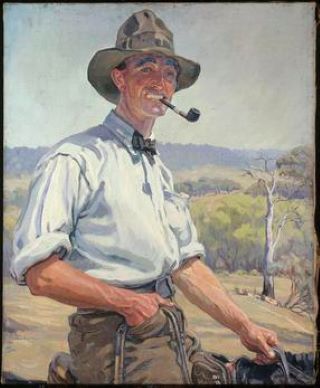Hilda Rix Nicholas Wright – Part Two
Yesterday we read about the artistic life of Hilda Rix Nicholas Wright, (click here if you missed it.) She produced many beautiful paintings reflecting her life and travel in Europe and Morocco. But Hilda also endured deep personal tragedy, particularly as a result of World War 1, which impacted upon her greatly for many years. Although she was a strong and vibrant person, these tragedies knocked her sideways. She relied upon her art to cope and come to terms with her great losses.
Briefly, Hilda lost her Father in 1907, and in 1914, her sister died. Then 18 months later, in 1916, both her Mother died and her new husband, George Matson Nicholas, died in the war. He was killed in battle only 5 weeks weeks after they were married, having returned to the front only 3 days after the wedding.....
So, in the space of two years, Hilda was left bereft, losing her mother, sister and new husband. In addition, one of her husband's brothers were also killed. She always retained the surname of Nicholas in memory of the loved Nicholas family and maintained the connection with his remaining brothers.
I think Hilda’s story is very sensitively told by the bookmark below from the Australian War Memorial website, and shows the depth of the impact on her of these events. It is very worthwhile reading:

I think it is incredible that Hilda was never given recognition as a war artist as I think these deeply personal sketches are very poignant and representative of the deep personal loss felt many times over by families whose loved husbands, brothers, fathers and sons never returned home.
Hilda returned to Australia in 1918, settling first in Melbourne and then in 1919 moving to Sydney where she set up a studio in an old stable at Mosman. She was strong, resilient and capable, and continued to paint scenes depicting the Australian way of life, touring rural New South Wales on painting trips. 1
In 1924, Hilda and close friend Dorothy Richmond travelled back to Europe on an extended trip. She took with her a number of her paintings - mainly pastoral scenes - with the intention of promoting Australia and Australian art. Exhibitions of her work were held in London and Paris. In Paris, Hilda hired a studio overlooking the Luxembourg Gardens and she and Dorothy lived there in a small attached area. 1
Together they toured regional France, with Hilda capturing life in small villages. In 1925 the French Government purchased another of her works, entitled In Australia.1 In 1926, Hilda was made an Associate of the Paris Salon, which entitled her to send up to 8 paintings a year to the Salon for exhibition.

Hilda and Dorothy returned to Australia in 1926.
As we read yesterday’s post, Hilda married Edgar Percy Wright in 1928, at age 43. His name was added to Rix Nicholas, so Hilda become known as Hilda Rix Nicholas Wright. She moved to his farming property, called Knockalong, near Delegate in New South Wales. In September 1930, aged 46, Hilda gave birth to their only child, a son, Barrie Rix, known as Rix.
Hilda remained at the station for the rest of her life, bringing up her son, painting and promoting Australian rural landscapes and life. She died and was buried there in 1961.
Lastly, another really wonderful thing in Hilda's full life is that she was also a prolific correspondent, writing often to friends and family. Her son Rix donated her letters to the National Library of Australia in 2003, which is a wonderful legacy for us all.
Whilst the copying and publishing them is protected by copyright, you may care to browse through some of her letters, particularly in Section 1, covering the years between 1912 and 1950. Click here to read her letters on the National Library of Australia website.
They provide a wonderful insight and depth to the personality, life and travels of this remarkable lady.
Footnotes
- Trove, National Library of Australia.
P.S. I have necessarily just skimmed the surface of this remarkable lady's life. Further reading about Hilda and her life and art is available on the following two pages from the Knockalong grazing property website:
-
Click here for an article by Dr. Gwen Rankin, who is an honorary research fellow of Deakin University.
-
Click here for more examples of Hilda's paintings.
Also, there is a very thorough account on Wikipedia: Click here.
